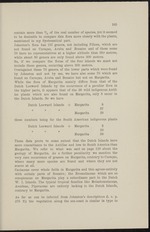| 1 |
 |
“...des Indes Néerlandaises Occidentales. Verhandelingen der Konin-
klijke Akademie van Wetenschappen. Amsterdam. Tweede Sectie.
Deel XVI. Nr. 3. 1910.
Illustrations du genre Melocactus. Livr. H.
Part of the plants collected by Suringar are mentioned by Urban
in his Symbol* Antillanse.
The other collections hat not been used by authors yet; they are
treated in this flora together with Suringar’s collection. In the
older literature on the Dutch W. L Islands something is found
on the flora there. With real pleasure I read and re-read after
my journey Teenstra’s work1), in which some 90 plants are des-
cribed in a manner which for a non-botanist is very sufficient.
From most of the descriptions the plants may be recognised,
especially since their wellknown indigenous names are given.
Like in Teenstra’s work much attention is paid to the medi-
*) M. D. Teenstra: De Nederlandsche West Indische eilanden in derzelver
tegenwoordige toestand. Amsterdam 1836—1837....”
|
|
| 2 |
 |
“...165
contain more than % of the real number of species, yet it seemed
to he desirable to compare this flora more closely with the plants,
mentioned in my Systematical part.
Johnston’s flora has 157 genera, not including Filices, which are
not found on Curasao, Aruba and Bonaire and of these some
70 have no representatives at a higher altitude than 300 metres,
while about 80 genera are only found above 300 metres.
So, if we compare the floras of the four islands we must not
include these genera, occurring above 300 metres.
Overagainst these 70 genera of the lower parts which were found
by Johnston and not by me, we have also some 70 which are
found on Curasao, Aruba and Bonaire but not on Margarita.
While the flora of Margarita mainly differs from that of the
Dutch -Leeward Islands by the occurrence of a peculiar flora in
the higher parts, it appears that of the 36 wild indigenous Antil-
les plants which are also found on Margarita, only 8 occur in
the Dutch Islands. So we have
Dutch Leeward...”
|
|
